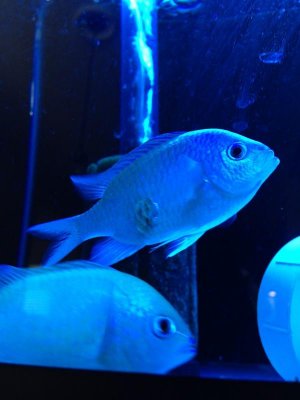Treats:
Amyloodinium (velvet)
Cryptocaryon (Ich)
Uronema marinum - with recurrence upon cessation and return to display
Possibly Brooklynella
Compatible with:
Praziquantil - YES (the known interaction has to do with cytochrome P450 in the first pass, hepatic metabolism of praziquantil and is not relevant when treating in bath formulation)
Amquel - YES
Prime - YES
Nitrofurazone (furan II) - YES
UV light - NO
Dimilin - YES
Copper - MAYBE (evidence exists that it my be synergistic)
Dosing:
10mg/l or 40mg/gal bath formulation
50 mg/kg - oral
Duration:
30 days - single dose - Ich
14 days - single dose - velvet
Degradation:
Carbon - removal
Light in the UV near visible light spectrum (390 nm) CF lighting with typical peaks in the 500s and 600s should be fine.
Half life:
After one oral dose at 50mg/kg - mucus levels remained therapeutic for 7 days and detectable for 30 days for velvet.
Activity:
In velvet, 10mg/l dose resulted in 100% dinospore inactivity at 48 hrs and 100% cure at 14 days. At a dose of 25 mg/l it took 24 hrs for 100% inactivity.
Lethal dose:
A dose of 200mg/l showed no adverse organ effects on necropsy.
Contraindications:
Pipefish
Sea dragons
possibly some wrasse
Miscellaneous:
Chloroquine has a known anti-inflammatory effect. In theory this could possibly reduce gill edema and increase oxygen transport (The gill edema and poor oxygen transport is what kills our fish)
It has been used in aquaculture since the late 70s
There is no known antibacterial activity and therefore will not effect biologic filtration
Strong algicidal activity
Amyloodinium (velvet)
Cryptocaryon (Ich)
Uronema marinum - with recurrence upon cessation and return to display
Possibly Brooklynella
Compatible with:
Praziquantil - YES (the known interaction has to do with cytochrome P450 in the first pass, hepatic metabolism of praziquantil and is not relevant when treating in bath formulation)
Amquel - YES
Prime - YES
Nitrofurazone (furan II) - YES
UV light - NO
Dimilin - YES
Copper - MAYBE (evidence exists that it my be synergistic)
Dosing:
10mg/l or 40mg/gal bath formulation
50 mg/kg - oral
Duration:
30 days - single dose - Ich
14 days - single dose - velvet
Degradation:
Carbon - removal
Light in the UV near visible light spectrum (390 nm) CF lighting with typical peaks in the 500s and 600s should be fine.
Half life:
After one oral dose at 50mg/kg - mucus levels remained therapeutic for 7 days and detectable for 30 days for velvet.
Activity:
In velvet, 10mg/l dose resulted in 100% dinospore inactivity at 48 hrs and 100% cure at 14 days. At a dose of 25 mg/l it took 24 hrs for 100% inactivity.
Lethal dose:
A dose of 200mg/l showed no adverse organ effects on necropsy.
Contraindications:
Pipefish
Sea dragons
possibly some wrasse
Miscellaneous:
Chloroquine has a known anti-inflammatory effect. In theory this could possibly reduce gill edema and increase oxygen transport (The gill edema and poor oxygen transport is what kills our fish)
It has been used in aquaculture since the late 70s
There is no known antibacterial activity and therefore will not effect biologic filtration
Strong algicidal activity
Last edited:


